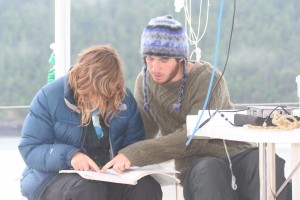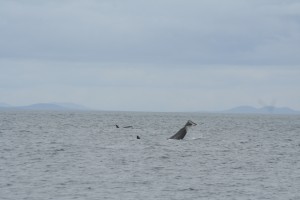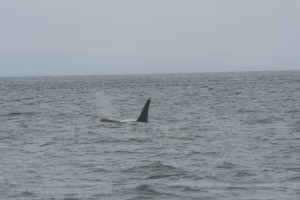Whale Soup!
It was like whale soup out there today! After a quiet period over the last week or so it was encouraging yesterday to hear that the whales had once again returned to the area. The killer whales were first heard in the early hours from the Lime Kiln hydrophones (http://orcasound.net/), however, as the morning progressed the whales were reported further north. We had our suspicions that they would be heading towards the Fraser river via Active Pass in search of Chinook salmon. Chinook salmon are thought to be the Southern resident’s preferred prey because of their large size and high lipid content. The navigation team responded to the various reports by planning a route to intercept the whales in the Strait of Georgia. Although we were a few hours behind the whales, the Gato finally caught up with the whales by the coal docks at Tsawwassen. The twelve or so whales at the docks were later identified as members of J pod. Although the seas were quite rough, we still managed to record over two hours of behavioural data. Unfortunately the whales weren’t vocal, and so little acoustic data was taken. After a great afternoon with the whales we headed to Patos Island for the night. It was the first time that this particular Beam Reach class had moored at Patos. Patos is one of the most northern islands in the San Juans, and is strategically located close to both the Strait of Georgia and Boundary Pass.
It was another early(ish) start this morning with the hope of catching up to the whales. Fortunately, the currents and tides were working in our favour. We met the whales between Salmon Bank and Hein Bank (a few miles south west of San Juan Island). There seemed to be a number of groups spread out across the Strait. Whereas the whale watch companies stuck with the ‘main group’ we decided to follow a smaller focal group of a few individuals. This decision paid off because we were able to record some great vocalisations. Over the hydrophone array we heard many S1 calls and clicks. The S1 call is the predominant call type for J pod and suggested to be a contact call. Contact calls are primarily used to establish the location of other pod members during certain behavioural states (Ford and Fisher 1983). Many of our research projects are focusing on S1 calls, and therefore the crew were delighted to hear them over the hydrophones. Not only were the whales vocal, they were seen spy hopping and tail slapping around the boat. Today was the first time that I had seen an Orca spy hop. I was completely lost for words. We stayed with this particular group for over two hours before riding the flood north back to Snug Harbor. Whales were also encountered as we neared Snug Harbor; these whales were also quite active, and were observed lunging out of the water. Over the last few days, we have recorded some incredible acoustic and behavioural data that we are still in the midst of processing and analyzing. Everyone is pleased that we have finally seen some whales. Hopefully this ‘whale run’ will continue over the next few days. I will keep you posted.






 Twitter
Twitter LinkedIn
LinkedIn Facebook
Facebook